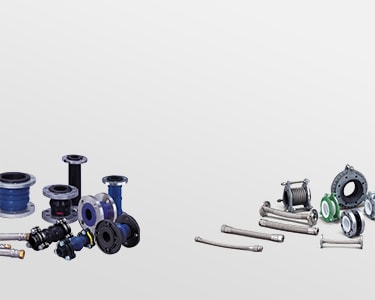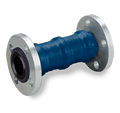
Technical data
Regarding specifications and management guidelines
Flexible joints
Editorial supervision by Government Buildings Department, Minister’s Secretariat, Ministry of Land, Infrastructure, Transport and Tourism
“Machinery and Equipment Work Supervision Guidelines,” 2019 edition
These are to be synthetic rubber, with a steel flange and reinforcing materials included, with sufficient flexibility, weatherability, heat resistance, and pressure resistance. Its overall length shall be as follows
- (a) The nominal diameter of 40 or less shall be 300mm or more.
- (b) The nominal diameter of 50 or 80 or less shall be 500mm or more.
- (c) The nominal diameter of 100 or more shall be 700mm or more.
TOZEN conforming products (cylinder type)
Joints to absorb displacement used in earthquake‐resistance measures related to tanks etc. are typically called flexible joints.
The name used in the “Machinery and Equipment Work Shared Specifications” was changed in 1989 edition from the previously-used native Japanese word “katō tsugite” to the English loan word “furekishiburu jointo.”
Editorial supervision by Government Buildings Department, Minister’s Secretariat, Ministry of Land, Infrastructure, Transport and Tourism
“Machinery and Equipment Work Supervision Guidelines,” 2019 edition
2.2.9 Flexible joints p.165~170
Table 2.2.6 Types of pipe joints
Based on SHSSE-S 008: 2008
| Types | Categories | Fluid application |
Pipe connection shape |
Working temperature(℃) |
Maximum working pressure(MPa) |
nominal diameter |
Face‐to‐face dimensions |
|---|---|---|---|---|---|---|---|
| Cylindrical pipe joint | Category A | Cold water Warm water Cooling water Heat source water Water supply Drainage |
Flange shape | 0~60 | 0.5※、1 or 2 | 20~600 | Integral multiple of 50 |
| Category B | 0~70 | 20~300 | Integral multiple of 50 | ||||
| Sphere type pipe joint | Category B | Manufacturer specifications | |||||
| Bellows type pipe joint | |||||||
| Flange shape Screw shape |
|||||||
0.5MPa is compatible with drainage systems
Table 2.2.7 Types of pipe joints
Based on SHASE-S 008:2008
| Categories | Maximum perpendicular displacement amount[mm] |
usage | Purposes |
|---|---|---|---|
| Category A | 100or more | Earthquake‐resistant applications |
Mainly absorbing sudden and large displacement due to earthquakes |
| Type designed to cope with ground subsidence | Mainly absorbing displacement due to ground subsidence at building entry points where there is a risk of subsidence |
||
| For seismic isolation | Mainly the absorption of displacement between seismically isolated buildings and the ground |
||
| Category B | Less than 100 | Protecting equipment and tanks in earthquakes |
Follow the displacement of the piping around equipment like a pump or water tank by earthquake or on-off operation of the equipment. |
(C)Synthetic rubber material(For water)
In the “Standards Specifications,” rubber displacement absorption pipe joints for use with water are specified as having a steel flange. In the SHASE-S 008: 2008 specifications (rubber displacement absorption pipe joints), pipe joints are divided into Category A and Category B based on the types and face‐to‐face dimensions shown in Table 2.2.6 and the range of maximum perpendicular displacement amounts shown in Table 2.2.7. The “Standards Specifications” show overall lengths for synthetic rubber flexible joints envisaging typical applications.
In addition, joints used in drinking water pipes shall present no hygiene issues nor adversely affect water quality.
It is preferable that EPDM with strengthened chlorine resistance is used on the rubber materials coming into contact with fluids in synthetic rubber flexible joints used in water supply systems where the residual chlorine concentration is high. (from Guidelines)
In recent years, direct water supply systems (high residual chlorine concentration) have come to be used in typical buildings, and the chlorine concentration in tap water has also further increased.
Rubber degradation occurs due to the oxidative effect of oxygen in the air and dissolved in fluids. This effect is significantly reinforced by heat, residual chlorine, copper, and salts such as manganese. This oxidative effect causes the rubber surface to become brittle, and rubber to peel away due to liquid flow, vibration, etc.
〈Our interpretation of categories〉
Products are divided into 2 categories based on the displacement amount, being Category A (100mm or more) and Category B (less than 100mm). It is possible that Category B also includes products between short surfaces compliant with standards specifications, but as the application is “protecting equipment and tanks in earthquakes” and the purpose is “…absorbing displacement… due to equipment starting and stopping as well as piping displacement due to earthquakes,” the main application and purpose is therefore absorbing displacement. A common-sense interpretation is thus that the Category B range will broadly cover products of 50mm or more and less than 100mm.
(Citing Asyu A1 of HASS 008-1999/HASS = current SHASE-S)


